Citroen JUMPY 2016 2.G Owner's Manual
Manufacturer: CITROEN, Model Year: 2016, Model line: JUMPY, Model: Citroen JUMPY 2016 2.GPages: 595, PDF Size: 12.47 MB
Page 241 of 595
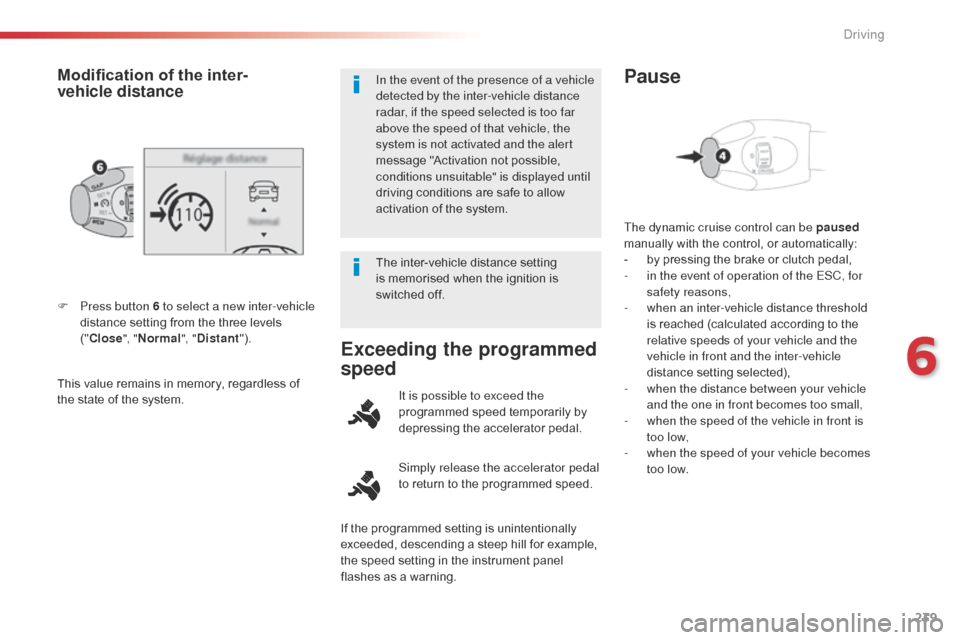
239
Jumpy _en_Chap06_conduite_ed01-2016
This value remains in memory, regardless of
the state of the system. F
P
ress button 6 to select a new inter-vehicle
distance setting from the three levels
("Close ", "Normal ", "Distant ").
Modification of the inter-
vehicle distanceIn the event of the presence of a vehicle
detected by the inter-vehicle distance
radar, if the speed selected is too far
above the speed of that vehicle, the
system is not activated and the alert
message "Activation not possible,
conditions unsuitable" is displayed until
driving conditions are safe to allow
activation of the system.
The inter-vehicle distance setting
is memorised when the ignition is
switched off.
Exceeding the programmed
speed
Simply release the accelerator pedal
to return to the programmed speed. It is possible to exceed the
programmed speed temporarily by
depressing the accelerator pedal. The dynamic cruise control can be paused
manually with the control, or automatically:
-
b
y pressing the brake or clutch pedal,
-
i
n the event of operation of the ESC, for
safety reasons,
-
w
hen an inter-vehicle distance threshold
is reached (calculated according to the
relative speeds of your vehicle and the
vehicle in front and the inter-vehicle
distance setting selected),
-
w
hen the distance between your vehicle
and the one in front becomes too small,
-
w
hen the speed of the vehicle in front is
too
low,
- w hen the speed of your vehicle becomes
too low.
Pause
If the programmed setting is unintentionally
exceeded, descending a steep hill for example,
the speed setting in the instrument panel
flashes as a warning.
6
Driving
Page 242 of 595
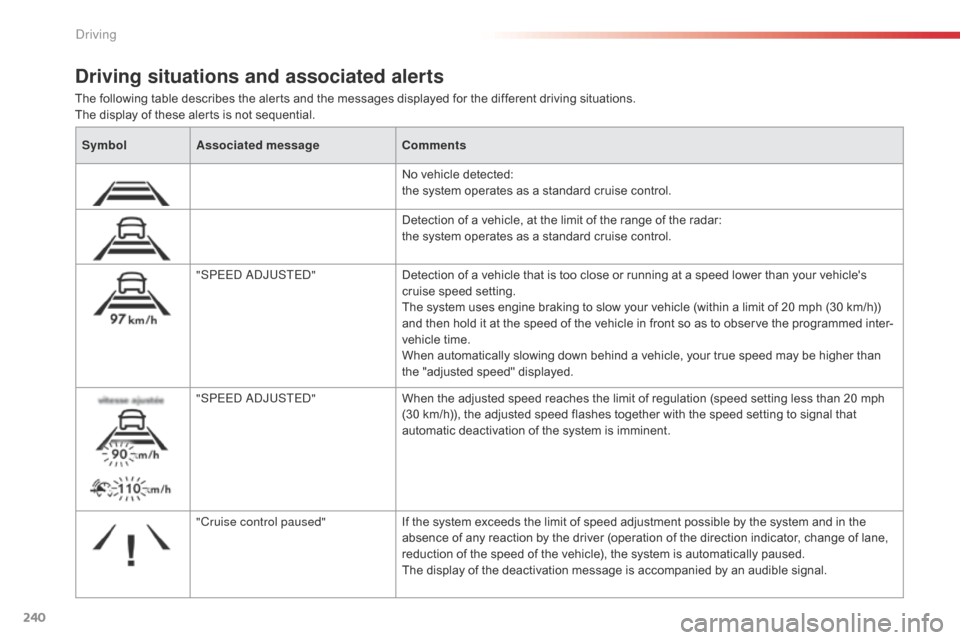
240
Jumpy _en_Chap06_conduite_ed01-2016
The following table describes the alerts and the messages displayed for the different driving situations.
The display of these alerts is not sequential.
Driving situations and associated alerts
SymbolAssociated message Comments
No vehicle detected:
the system operates as a standard cruise control.
Detection of a vehicle, at the limit of the range of the radar:
the system operates as a standard cruise control.
"SPEED ADJUSTED" Detection of a vehicle that is too close or running at a speed lower than your vehicle's
cruise speed setting.
The system uses engine braking to slow your vehicle (within a limit of 20 mph (30 km/h))
and then hold it at the speed of the vehicle in front so as to observe the programmed inter-
vehicle time.
When automatically slowing down behind a vehicle, your true speed may be higher than
the "adjusted speed" displayed.
"SPEED ADJUSTED" When the adjusted speed reaches the limit of regulation (speed setting less than 20
mph
(30 km/h)), the adjusted speed flashes together with the speed setting to signal that
automatic deactivation of the system is imminent.
"Cruise control paused" If the system exceeds the limit of speed adjustment possible by the system and in the
absence of any reaction by the driver (operation of the direction indicator, change of lane,
reduction of the speed of the vehicle), the system is automatically paused.
The display of the deactivation message is accompanied by an audible signal.
Driving
Page 243 of 595

241
Jumpy _en_Chap06_conduite_ed01-2016
When the dynamic cruise control is
automatically paused, it can only be
reactivated when safe conditions are
restored. The message "Activation
not possible, conditions unsuitable"
is displayed while reactivation is not
possible.
When the conditions allow, it is
recommended that the function be
reactivated by pressing button 2 (SET+)
or 3 (SET-), which will make the current
speed of your vehicle the new cruise
speed setting, rather than by pressing
button 4 (on/pause) which reactivates
the cruise control using the old cruise
speed setting, which may be very
different from the current speed of your
vehicle.The speed regulation range is limited to a
maximum difference of 20 mph (30 km/h)
between the speed setting and the speed of
the vehicle in front.
Above this, the system goes into pause if the
safe distance becomes too small.
The dynamic cruise control uses only engine
braking to slow the vehicle. Consequently the
vehicle loses speed slowly, as when releasing
the accelerator pedal.
The system is paused automatically:
-
i
f the vehicle in front slows down too much
or too suddenly, and the driver does not
brake,
-
i
f a vehicle comes between your vehicle
and the vehicle in front,
-
i
f the system does not slow the vehicle
enough to continue to maintain a safe
distance, for example when descending a
steep hill.Limits of operation
As the radar's field of detection is quite narrow,
it is possible that the system may not detect:
-
v
ehicles of reduced width, such as
motorcycles, for example, -
v
ehicles not running in the middle of the
lane,
-
v
ehicles entering a corner,
-
v
ehicles changing lane at the last moment.
The cruise control does not take
account of:
- s tationary vehicles,
-
v
ehicles driving in the opposite
direction.
6
Driving
Page 244 of 595
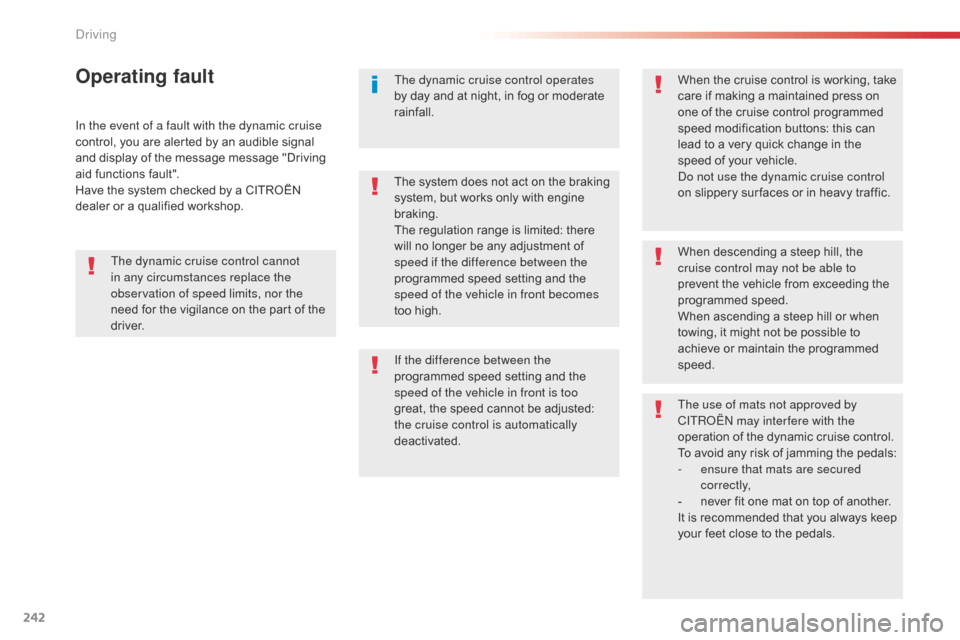
242
Jumpy _en_Chap06_conduite_ed01-2016
In the event of a fault with the dynamic cruise
control, you are alerted by an audible signal
and display of the message message "Driving
aid functions fault".
Have the system checked by a CITROËN
dealer or a qualified workshop.
Operating faultThe dynamic cruise control operates
by day and at night, in fog or moderate
rainfall.When the cruise control is working, take
care if making a maintained press on
one of the cruise control programmed
speed modification buttons: this can
lead to a very quick change in the
speed of your vehicle.
Do not use the dynamic cruise control
on slippery sur faces or in heavy traffic.
When descending a steep hill, the
cruise control may not be able to
prevent the vehicle from exceeding the
programmed speed.
When ascending a steep hill or when
towing, it might not be possible to
achieve or maintain the programmed
speed.
The use of mats not approved by
CITROËN may inter fere with the
operation of the dynamic cruise control.
To avoid any risk of jamming the pedals:
-
e
nsure that mats are secured
c o r r e c t l y,
-
n
ever fit one mat on top of another.
It is recommended that you always keep
your feet close to the pedals.
If the difference between the
programmed speed setting and the
speed of the vehicle in front is too
great, the speed cannot be adjusted:
the cruise control is automatically
deactivated. The system does not act on the braking
system, but works only with engine
braking.
The regulation range is limited: there
will no longer be any adjustment of
speed if the difference between the
programmed speed setting and the
speed of the vehicle in front becomes
too high.
The dynamic cruise control cannot
in any circumstances replace the
observation of speed limits, nor the
need for the vigilance on the part of the
driver.
Driving
Page 245 of 595
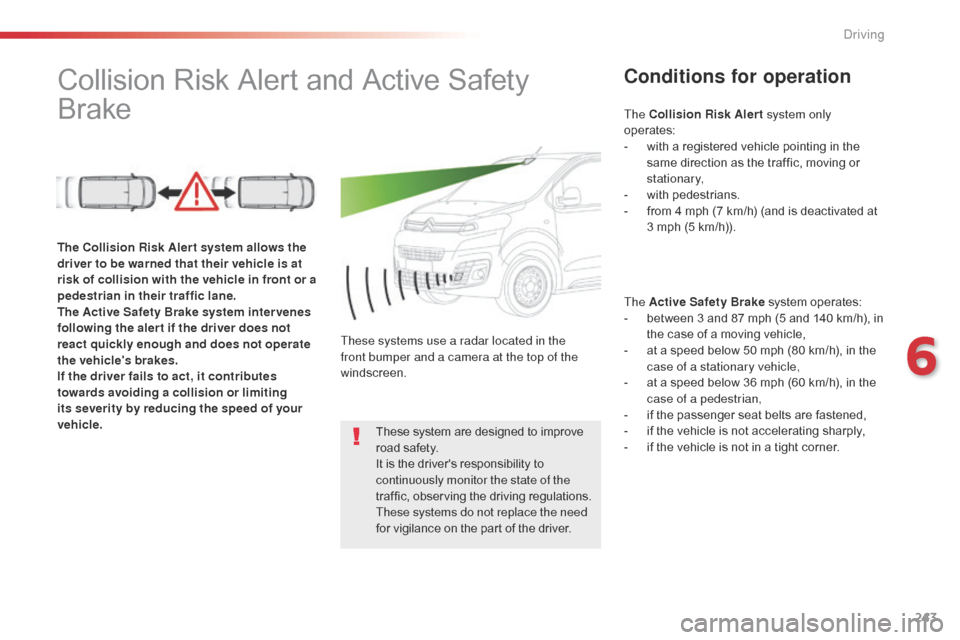
243
Jumpy _en_Chap06_conduite_ed01-2016
Collision Risk Alert and Active Safety
BrakeConditions for operation
The Active Safety Brake system operates:
- b etween 3 and 87 mph (5 and 140 km/h), in
the case of a moving vehicle,
-
a
t a speed below 50 mph (80 km/h), in the
case of a stationary vehicle,
-
a
t a speed below 36 mph (60 km/h), in the
case of a pedestrian,
-
i
f the passenger seat belts are fastened,
-
i
f the vehicle is not accelerating sharply,
-
i
f the vehicle is not in a tight corner.
The
Collision Risk Alert system allows the
driver to be warned that their vehicle is at
risk of collision with the vehicle in front or a
pedestrian in their traffic lane.
The Active Safety Brake system inter venes
following the aler t if the driver does not
react quickly enough and does not operate
the vehicle's brakes.
If the driver fails to act, it contributes
towards avoiding a collision or limiting
its severity by reducing the speed of your
vehicle. These systems use a radar located in the
front bumper and a camera at the top of the
windscreen.
These system are designed to improve
road safety.
It is the driver's responsibility to
continuously monitor the state of the
traffic, observing the driving regulations.
These systems do not replace the need
for vigilance on the part of the driver. The Collision Risk Alert
system only
operates:
-
w
ith a registered vehicle pointing in the
same direction as the traffic, moving or
stationary,
-
w
ith pedestrians.
-
f
rom 4 mph (7 km/h) (and is deactivated at
3 mph (5 km/h)).
6
Driving
Page 246 of 595
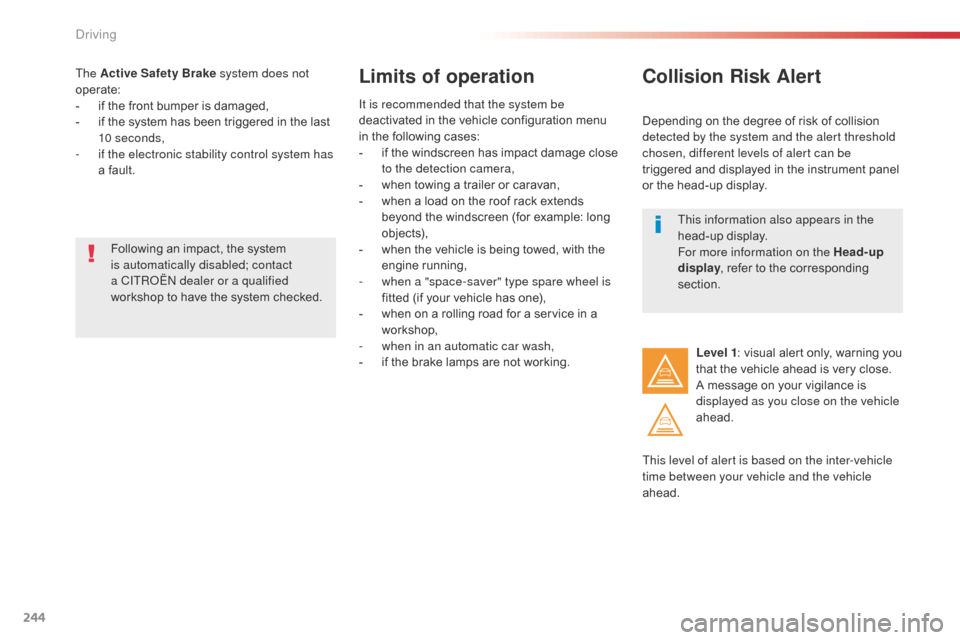
244
Jumpy _en_Chap06_conduite_ed01-2016
The Active Safety Brake system does not
operate:
-
i
f the front bumper is damaged,
-
i
f the system has been triggered in the last
10 seconds,
-
i
f the electronic stability control system has
a fault.Limits of operation
It is recommended that the system be
deactivated in the vehicle configuration menu
in the following cases:
-
i
f the windscreen has impact damage close
to the detection camera,
-
w
hen towing a trailer or caravan,
-
w
hen a load on the roof rack extends
beyond the windscreen (for example: long
objects),
-
w
hen the vehicle is being towed, with the
engine running,
-
w
hen a "space-saver" type spare wheel is
fitted (if your vehicle has one),
-
w
hen on a rolling road for a service in a
workshop,
-
w
hen in an automatic car wash,
-
i
f the brake lamps are not working.
Following an impact, the system
is automatically disabled; contact
a CITROËN dealer or a qualified
workshop to have the system checked.
Collision Risk Alert
Depending on the degree of risk of collision
detected by the system and the alert threshold
chosen, different levels of alert can be
triggered and displayed in the instrument panel
or the head-up display.
This level of alert is based on the inter-vehicle
time between your vehicle and the vehicle
ahead. Level 1
: visual alert only, warning you
that the vehicle ahead is very close.
A message on your vigilance is
displayed as you close on the vehicle
ahead.
This information also appears in the
head-up display.
For more information on the Head-up
display
, refer to the corresponding
section.
Driving
Page 247 of 595

245
Jumpy _en_Chap06_conduite_ed01-2016
This level of alert is based on the time before
collision. It takes account of the vehicle
dynamics, the speed of your vehicle and the
one in front, the environmental conditions, the
operation of the vehicle (cornering, pedals
pressed, etc.) to trigger the alert at the best
moment.Level 2
: visual and audible alert,
warning you that a collision is
imminent.
A message indicating that you should
brake is displayed.
Where the speed of your vehicle is too
high approaching another vehicle, the
first level of alert may not be displayed:
the level 2 alert may be displayed
di r e c t l y.
Furthermore, the level 1 alert is never
displayed with the " Close" threshold.
Poor weather conditions (very heavy
rain, accumulation of snow in front of
the radar and the camera) may hinder
the operation of the system, with the
display of an operating fault message.
The system remains out of service until
the message disappears.
Programming the alert
thresholds
The thresholds for triggering an alert determine
how you wish to be warned of the presence of a
vehicle moving or stationary ahead of you, or a
pedestrian in your traffic lane.
You can select one of three thresholds:
-
"Distant ", to be warned early (cautious
driving).
-
"Normal ".
-
"Close ", to be warned later.
In the vehicle settings menu, activate/
deactivate "Collision risk alert and automatic
braking ".
With the touch screen With the audio system
In the "Personalisation-configuration "
menu, activate/deactivate " Auto. emergency
braking ".
Then modify the alert threshold.
Then modify the alert threshold.
Press on " Confirm" to save the change.
6
Driving
Page 248 of 595

246
Jumpy _en_Chap06_conduite_ed01-2016
This system, also called automatic emergency
braking, aims to reduce the speed of impact
or avoid a frontal collision by your vehicle
(between 3 and 87 mph (5 and 140 km/h))
where the driver fails to react.
Using a radar and a camera, this system acts
on the vehicle's braking system.
Active Safety Brake
The driver can take back control of the vehicle
at any time by sharply turning the steering
wheel and/or pressing the accelerator pedal.Operation of the system may be felt by
slight vibration in the brake pedal.
If the vehicle comes to a complete stop,
the automatic braking is maintained
for
1 to 2 seconds.
If your vehicle has a manual gearbox, in
the event of the automatic emergency
braking bringing the vehicle to a
complete stop, the engine may stall.
If your vehicle has an automatic
gearbox, in the event of the automatic
emergency braking bringing the vehicle
to a complete stop, the vehicle will
move off again; press the brake pedal.
If automatic emergency braking is
not activated, you are alerted by the
fixed display of this warning lamp
accompanied by a message.
If the radar and the camera have
confirmed the presence of a vehicle
or a pedestrian, this warning lamp
flashes when the system is operating.
Important
: if operation of the
automatic emergency braking is
triggered, you should take back
control of your vehicle and brake
with the pedal to add to or finish the
automatic braking.
The point at which braking is triggered
may be adjusted according to the
reaction from the driver, such as
movement of the steering wheel or
pressing the accelerator pedal.
Driving
Page 249 of 595

247
Jumpy _en_Chap06_conduite_ed01-2016
Deactivation / Activation of
the alert and the braking
By default, the function is automatically
activated at every engine start.
The deactivation or activation of the function is
done in the vehicle configuration menu.
With the audio system
In the "Personalisation-configuration "
menu, activate/deactivate " Auto. emergency
braking ".
Intelligent emergency
braking assistance
If the driver does not brake sufficiently
to avoid an accident, this system will
complete the braking.
This emergency braking system will not
act if you press the brake pedal.
With the touch screen
In the vehicle settings menu, activate/
deactivate " Collision risk alert and automatic
braking ". In the event of a fault, you are alerted
by the illumination of this warning
lamp, accompanied by an audible
signal and a message.
Contact a CITROËN dealer or a
qualified workshop.
Operating fault
There may be interference in the
operation of the camera or it not work at
all in the following situations:
-
p
oor visibility (inadequate street
lighting, falling snow or rain, fog, ...),
-
d
azzle (headlamps of an
approaching vehicle on the other
side of the road, low sun, reflection
on a wet road, leaving a tunnel,
alternating between light and
shade, ...),
-
t
he area in front of the windscreen:
dirty, misty, frosty, snow-covered,
damaged or covered by a sticker.
The operation of the radar, located in
the front bumper, may be disturbed
in certain weather conditions: with
accumulations of snow, ice, mud, ...
6
Driving
Page 250 of 595

248
Jumpy _en_Chap06_conduite_ed01-2016
Clean the front bumper, removing the
snow, mud, ... If one of the two sensors (camera
or radar) is masked or its visibility
is reduced, while the other sensor
is able to work normally, the system
still operates, but at a lower level of
per formance. This is not indicated by a
message or a warning lamp.
To ensure correct operation of the radar
radar, do not paint over the paintwork
on the vehicle's bumper.
Keep the windscreen in front of the
camera clean.
Do not allow snow to accumulate on
the bonnet or roof of the vehicle as this
could mask the camera's view.
Lane departure warning system
System that uses a camera to recognise
continuous or broken lines on traffic lanes and
triggers an alert if the vehicle wanders off line.
If the direction indicator is not used at speeds
above 37 mph (60 km/h) and there is a risk of
one of these lines on the ground being crossed,
the system triggers the alert.
The system is particularly useful on motor ways
and fast roads.
Detection - Alert
You are alerted by the flashing of
this warning lamp in the instrument
panel, accompanied by an audible
signal.
No alert is given while the direction
indicators are operating and for
approximately 20 seconds after the
direction indicators are switched off.
The lane departure warning system
cannot in any circumstances replace
the need for vigilance on the part of the
driver.
It is necessary to observe the driving
regulations and to take a break every
two hours.
Driving